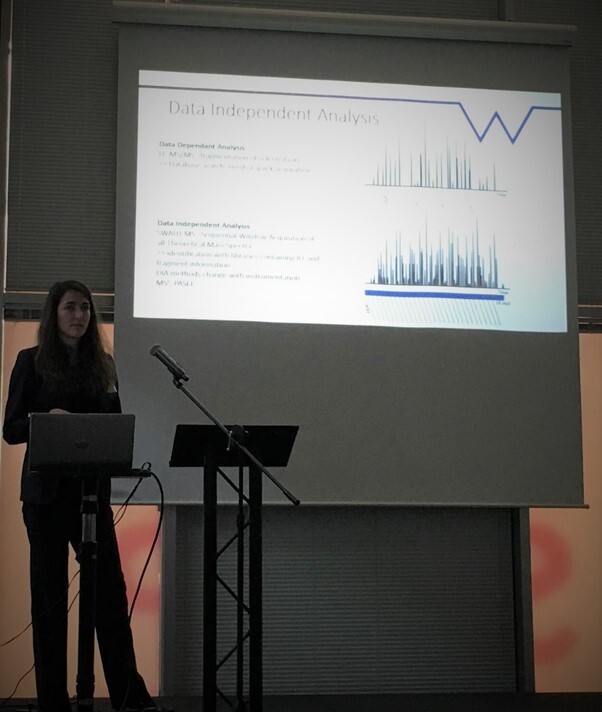Johanna Paris
My research focus on detection and fragmentation of post translational modifications using 12T FT-ICR solariX and two-dimensional mass spectrometry, under the supervision of Peter O'Connor (Warwick university) and John O'Hara (UCB).
Fragmentation methods
CAD, IRMPD, ECD, EDD and UVPD were applied to three phosphopeptides. The comparison of the fragmentation profiles highlighted the different fragmentation mechanisms. (Paper send to JASMS)
2DMS - in the analysis of proteomic samples.
Two dimensional mass spectrometry (2DMS) is an alternative data-independent analysis approach which allows the simultaneous fragmentation of precursors, while still retaining the information of which precursor produced which fragments.
2DMS was applied to a phosphopeptides mixture. The extraction of neutral loss lines allowed the quick identification of which peptides were phosphorylated. The extraction of fragment lines, where are all fragments related to one precursor, allowed the localisation of the phosphorylation on the phosphopeptides. (Paper)
2DMS was applied to two bottom up antibody samples, a stressed sample and a control sample. The comparison of the 2DMS spectra allowed the identification and localisation of post translational modifications. Higher resolution was achieved using the 3D peak picking algorithm. (Paper)
Top down Approach
Antibody topdown experiment was investigated. Antibody light chain, histones, and myoglobin were fragmented using CAD, IRMPD, ECD and UVPD dissociation techniques.
Conferences
BMSS Birmingham, 2015
ProteoMMX 4.0 Chester, 2016
Glycobiotech Berlin, 2017
BMSS Manchester, 2017 (Poster)
Uppcon Leeds, 2018 (Poster)
EU FT-ICR 2018, Finland (Poster)
BMSS, Manchester 2018 (Poster)
1rst European Consortium in Top Down, Paris, 2019 (Poster)
Native MS, Oxford, 2019 (Poster)
BMSS Manchester 2019 (Poster)
EU FT-ICR Warwick 2019 (Talk: 2DMS of phosphopeptides)
EMPW Sheffield 2019 (Talk: Unravel PTMs with 2DMS)
Personal Profile
I graduated from the E.N.S.T.B.B (Ecole Nationale des technologies des biomolecules de Bordeaux).
My Master degree is specialised in Biotechnology.
Work Experience at UCB (3years)
Analysis of antibody therapeutics using UPLC or LC-MS/MS methods to understand their degradation pathway, the impact of cell cultures parameters or process changes, their CQAs as well as basic and acidic species or colouration investigation.
Innovative project: Development and implementation of mass spectrometry methods using isotopic labelling strategy to quantify post-translational modifications.
Glycan Project: Analysis of the N-glycans pattern by N-glycan release methods using different labels (UPLC) and quantitative analysis of sialic acids (UPLC) for comparability studies, clone selection and clone stability studies.
Instruments: Thermo exactive + (Orbitrap), Waters Qtof (Synapt and Xevo), Agilent Qtof (chip-cube), UPLC H Class (QDA and FLR).
Software: Xcalibur, Masslynx, Agilent softwares, Biopharmafinder, Biopharmalynx, Pinpoint, Skyline, Empower.
Techniques: LC-MS/MS peptide mapping, LC-MS/MS disulphide peptide mapping, LC-MS intact mass, HPLC/UPLC (HILIC, RP,CEX, SEC).
Work Placement at UCB (8months)
Development of quantitative mass spectrometry methods to measure Post-Translational Modifications of an antibody, using the stable isotope-labelled internal standard (SILIS) strategy.
Production of the labelled antibody by metabolic incorporation using CHO cells, purification of the labelled material (Protein A affinity chromatography with an AKTA purifier and UNICORN software), calculation of the labelling efficiency (Agilent 6510 QTof) and use of the SITRS protein as an internal standard in peptide mapping analysis to quantify PTMs (Xevo G2 QTof).
Work Placement at Sanofi Pasteur (6months)
Monitoring tools for High Throughput Process Development Robots :
- Development of RP-UHPLC and UHP-SEC methods for proteins
- Use of Agilent 1290 and ChemStation Software
Work Placement at CHU Toulouse (3months)
Laboratoire de pharmacocinétique et de toxicologie clinique
Development of RP-UPLC method to quantify methotrexate in the blood.
Johanna Paris
MAS-CDT phD (FT-ICR MS)
in collaboration with UCB
johanna.paris@warwick.ac.uk

